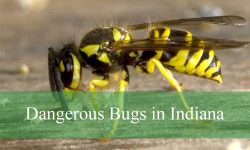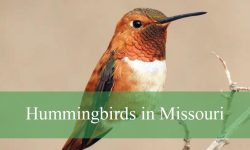Ohio’s natural beauty is enriched by the presence of many small, energetic birds known as wrens. These tiny songsters bring charm and melody to a variety of habitats—from dense woodlands and shrubby fields to peaceful wetlands and even backyard gardens. Each species has its own unique song, behavior, and look that makes discovering them a joyful experience for any nature lover.
Wrens are known for their lively personalities and often curious nature, flitting actively through branches, leaf litter, and marsh grasses. In Ohio, eight distinct types of wrens can be found, each adapted to different environments and seasons. Whether it’s the bubbly song of the House Wren or the rich, repeated calls of the Carolina Wren, these birds add a special soundtrack to the state’s outdoors.
If you enjoy birdwatching or simply want to deepen your connection with Ohio’s wildlife, learning to identify these wrens by their appearance and song is a wonderful place to start. This guide will introduce you to eight fascinating wrens commonly found in Ohio, helping you spot, listen to, and appreciate these spirited birds in their natural homes.
Common Wrens Found in Ohio
House Wren (Troglodytes aedon)
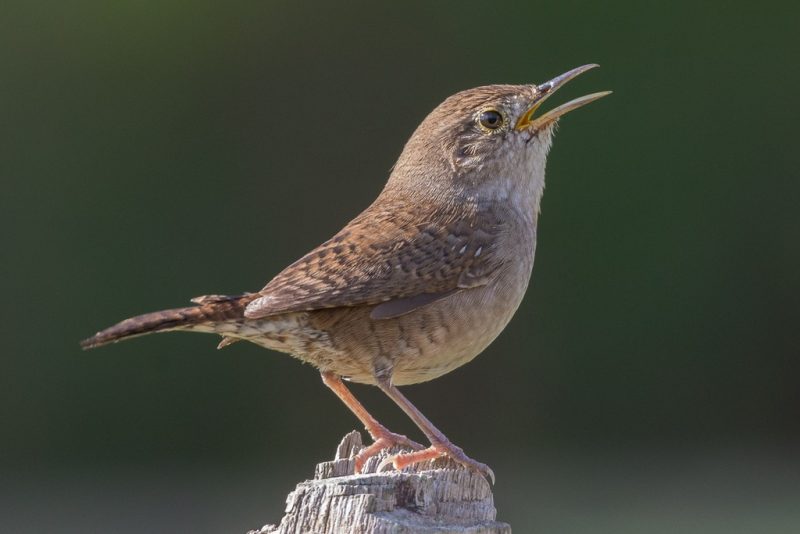
The House Wren is a small, lively bird measuring about 4 to 5 inches in length with a wingspan of approximately 6 to 7 inches. Its plumage is warm brown with subtle barring on the wings and tail, and a faint pale eyebrow stripe that helps distinguish it from similar species. The tail is often held upright, a common characteristic of wrens. Its compact size and short, slightly curved bill make it well-suited for probing into crevices and dense foliage.
This species is highly active and vocal, known for its bubbly and complex song that fills gardens, suburban areas, woodlands, and shrublands throughout Ohio during the breeding season. Male House Wrens are territorial and use their persistent singing to defend their nesting area against rivals. Their nests are usually built in cavities or nest boxes, and they often use man-made structures for nesting, which makes them common near human dwellings.
House Wrens primarily feed on insects and spiders, foraging actively through leaf litter, shrubs, and tree branches. Their diet includes caterpillars, beetles, ants, and occasionally small snails, which they capture by gleaning or probing. They rarely eat seeds or fruit, relying mostly on animal prey, which they find by hopping and flicking their wings in a lively manner.
In Ohio, House Wrens prefer habitats with dense brush or shrubs near open areas for foraging. They are found across the state in spring and summer, migrating south for the winter. Their adaptability to various habitats, including urban areas, helps maintain stable populations despite habitat changes.
Carolina Wren (Thryothorus ludovicianus)
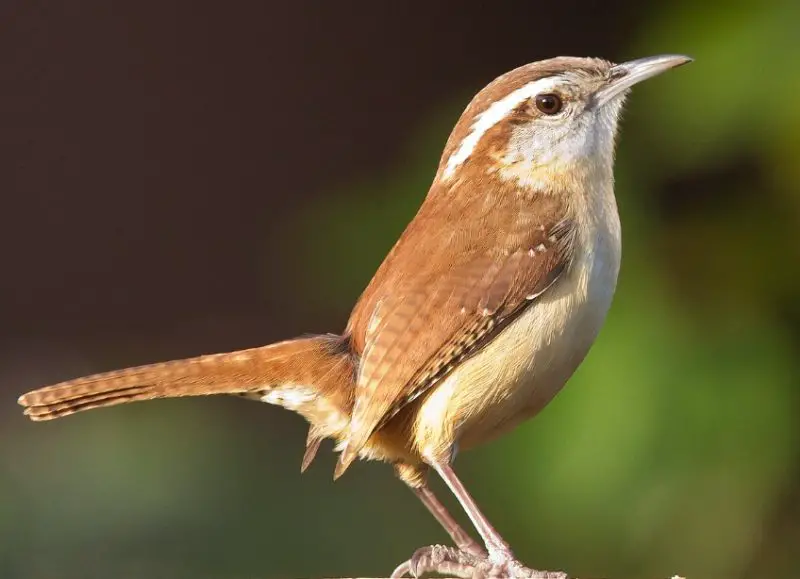
Carolina Wrens are a bit larger than House Wrens, measuring about 5 to 6 inches in length with a wingspan of around 8 to 9 inches. Their striking plumage features rich reddish-brown upperparts, a bright rusty underbelly, and a bold white stripe above each eye, which makes them easily recognizable. They have a long tail often cocked upward and a thick, slightly curved bill, adapted for hunting insects in dense cover.
This species is a year-round resident in Ohio and favors thick brush, forest edges, dense thickets, and suburban gardens with ample shrubbery. Carolina Wrens are known for their loud, repeated “teakettle-teakettle” song that carries well even through dense vegetation. Males sing frequently to establish territory and attract mates, often continuing vocalizing throughout the year.
Carolina Wrens primarily feed on insects, spiders, and other invertebrates, but during colder months, they may also eat small fruits and seeds. They forage near the ground and low vegetation, often hopping around logs, brush piles, and fallen branches to uncover prey. Their active foraging and inquisitive nature make them common visitors to bird feeders, especially when mealworms or suet are offered.
This species shows remarkable adaptability and resilience, able to survive harsh Ohio winters by seeking shelter in protected areas such as dense vines, brush piles, or even inside structures. Their ability to tolerate cold weather and utilize a variety of habitats contributes to their stable populations throughout the state.
Winter Wren (Troglodytes hiemalis)

The Winter Wren is one of Ohio’s smallest wrens, measuring approximately 3.5 to 4 inches in length with a wingspan of 5 to 6 inches. It is characterized by dark brown plumage with fine barring across the wings, back, and tail, which is short and usually held upright. Its compact body and short tail help it maneuver through dense undergrowth and forest floors with ease. The Winter Wren is less conspicuous visually but is often detected by its loud, complex, and bubbly trill.
This shy and elusive bird prefers dense, moist coniferous or mixed forests, especially in the Appalachian regions and hilly southern Ohio. Its preferred habitat includes thick mossy areas, fallen logs, and dense understory vegetation, providing excellent cover and nesting sites. Winter Wrens are generally solitary or found in pairs during the breeding season.
Winter Wrens forage actively by probing bark crevices, leaf litter, and mossy ground for insects, larvae, spiders, and other small invertebrates. Their diet is strictly carnivorous, relying on the abundance of forest floor insects. Despite their small size, their song is surprisingly loud and complex, used to mark territory and attract mates during the short breeding season.
In Ohio, Winter Wrens migrate south in the fall but may occasionally overwinter in milder areas of the state if conditions allow. Their presence is a good indicator of healthy, mature forest habitats. Due to their secretive nature and dense habitat, sightings can be rare, but their distinctive song often reveals their presence.
Sedge Wren (Cistothorus platensis)
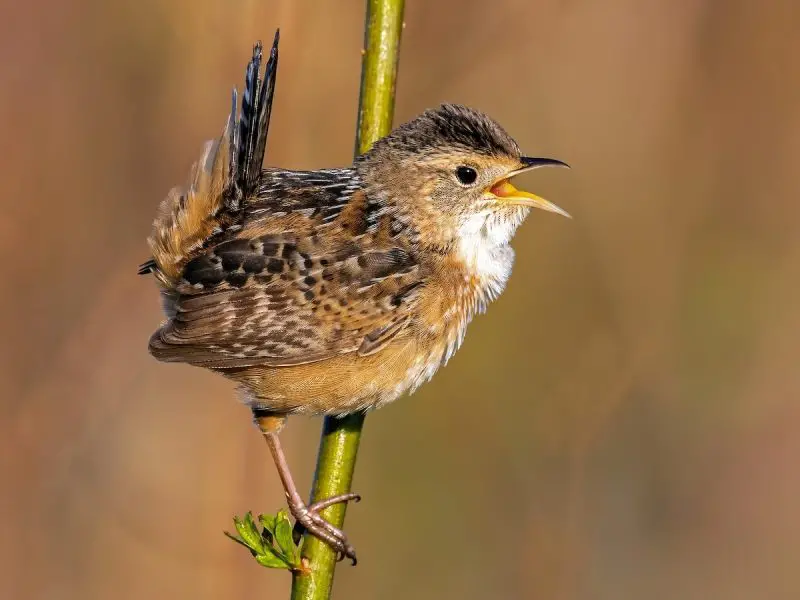
The Sedge Wren is a small, secretive bird about 4 inches long with a wingspan of nearly 7 inches. Its plumage is a blend of streaked brown upperparts and a buffy, spotted breast, providing excellent camouflage in the grassy, sedge-filled wetlands where it lives. The bird’s short tail is often held upright, and its small size and elusive behavior make it difficult to spot.
This species is strongly associated with wet meadows, marshes, and sedge-dominated grasslands in Ohio, especially during the breeding season. The Sedge Wren’s habitat choice often limits its distribution to areas with dense, low vegetation near water. Its song consists of a rapid series of buzzy, harsh notes and trills that carry across open habitats, useful for territory establishment.
Sedge Wrens feed primarily on insects and spiders, which they catch by skulking low in thick vegetation and picking prey off stems and leaves. Their insectivorous diet includes beetles, caterpillars, and other small arthropods. They build nests low in dense vegetation, often using grasses and sedges to conceal their carefully woven cup-shaped nests.
Due to their secretive nature and habitat preferences, Sedge Wrens can be hard to observe despite being relatively common in suitable wetland environments. In Ohio, their populations are closely linked to the availability of quality wet meadows and marsh habitats, which are vulnerable to drainage and development.
Marsh Wren (Cistothorus palustris)
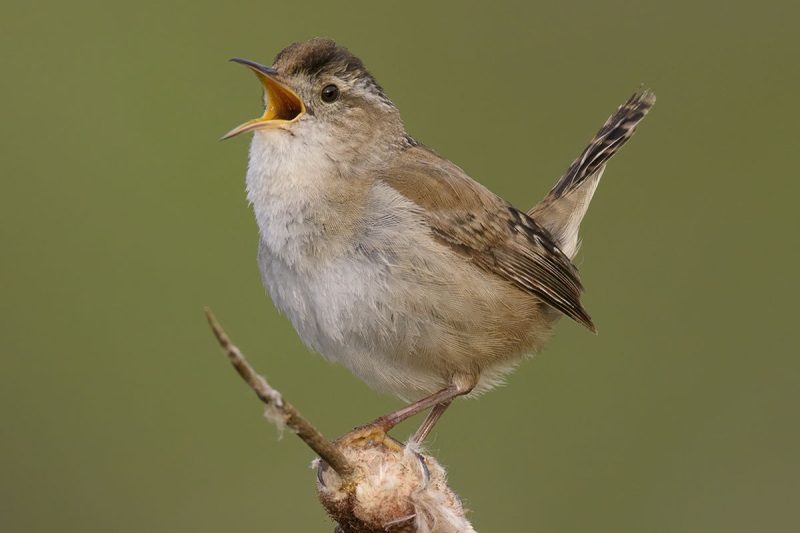
The Marsh Wren is a small bird about 4 to 5 inches long with a wingspan close to 7 inches. It features dark brown upperparts streaked with black and a distinctive white line over the eye, which helps distinguish it from similar species like the Sedge Wren. Its tail is often held upright, and its plumage provides excellent camouflage among reeds and cattails in wetland habitats. This bird is well-adapted to marshy environments and is rarely seen far from dense emergent vegetation.
In Ohio, Marsh Wrens inhabit freshwater marshes, swamps, and wet meadows, especially those dominated by cattails and other tall grasses. Their preferred habitats offer dense cover for nesting and foraging, making these birds quite secretive and challenging to observe. During the breeding season, males aggressively defend their territories with loud, bubbly songs that can carry over open water and through dense vegetation.
Marsh Wrens primarily feed on insects and spiders, foraging among reeds and cattails by gleaning prey from leaves and stems. Their diet includes beetles, flies, and various aquatic insects, which they catch with quick, deliberate movements. Their strong legs and feet allow them to cling to vertical stems as they search for food.
Nesting behavior is notable; males may build multiple “dummy” nests within their territory to attract females, who then select one for actual egg-laying. The nest is usually a globe-shaped structure woven from reeds, with a side entrance, hidden deep in marsh vegetation. This species’ reliance on healthy wetlands makes it sensitive to habitat loss and degradation in Ohio.
Bewick’s Wren (Thryomanes bewickii)
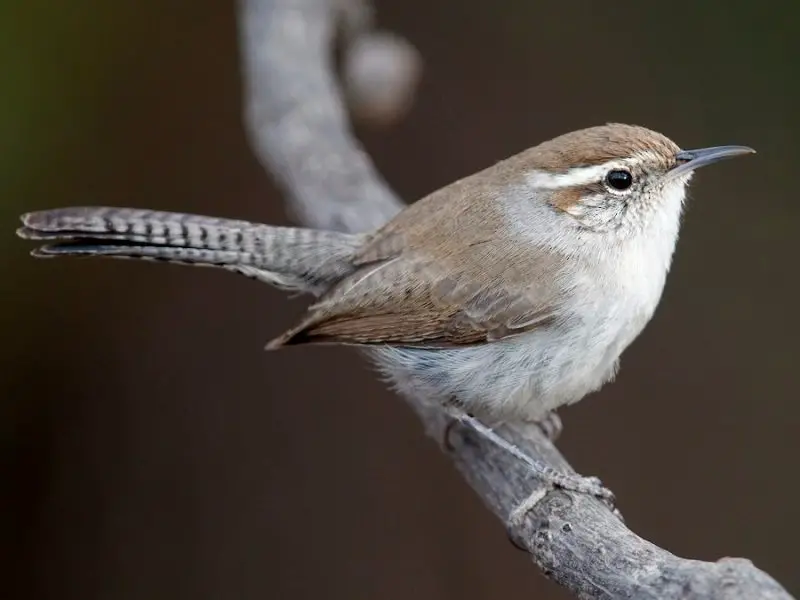
Bewick’s Wren is a medium-sized wren, slightly larger than House and Sedge Wrens, measuring about 5 inches in length with a wingspan near 7 to 8 inches. Its plumage is light brown with a pale underside, and it has a prominent white eyebrow stripe that contrasts with its darker face. This species is known for its long tail, often held erect, and its clear, melodious song that varies regionally.
While Bewick’s Wrens are more common in western parts of the United States, they have been recorded as rare visitors or occasional breeders in Ohio, especially in shrubby or brushy habitats. They prefer open woodlands, thorny thickets, and edges of forests, often in areas with rocky outcrops or old buildings where they can nest in cavities or crevices.
Their feeding habits include a diet of insects, spiders, and occasionally small fruits, which they actively search for by hopping through branches and foliage. Bewick’s Wrens are known for their bold and curious behavior, frequently investigating bird feeders and human structures when available.
Due to their rarity in Ohio, Bewick’s Wrens are not often seen, but their distinctive song and behavior make them memorable when encountered. Their adaptability to various brushy habitats allows them to exploit niches that other wrens may not frequent.
Canyon Wren (Catherpes mexicanus)
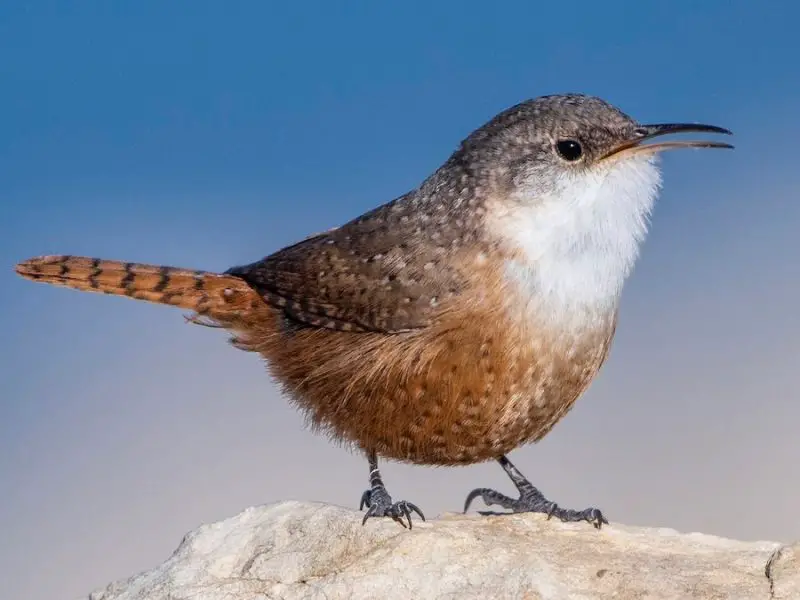
The Canyon Wren is a medium-sized wren measuring approximately 5 to 6 inches in length with a wingspan around 7 to 8 inches. It has a unique rusty-red to cinnamon-colored back and tail, with a pale, buffy underside and barred wings. Its long, slightly curved bill is well-suited for probing into rocky crevices. The Canyon Wren is known for its distinctive, melodious cascading song that echoes in its preferred rocky environments.
Though primarily found in the western U.S., Canyon Wrens are very rare in Ohio and might only appear as vagrants or during unusual dispersal events. Their habitat preference includes rocky cliffs, canyons, and steep outcrops where they can nest and forage among crevices and boulders. Such habitats are limited in Ohio, contributing to their rarity.
The Canyon Wren’s diet consists mainly of insects and spiders, which it skillfully extracts from cracks and crevices in rocky terrain. Its foraging behavior involves hopping along rock faces and probing with its bill. This species is quite territorial, using its loud, clear song to communicate across rocky canyons.
Because of its rarity in Ohio, sightings are extremely uncommon and usually attract birders’ special interest. The bird’s striking plumage and haunting song make it distinctive when encountered, but its primary range remains far west of Ohio.
Rock Wren (Salpinctes obsoletus)

The Rock Wren is a small to medium wren, roughly 5 to 6 inches long with a wingspan near 8 inches. Its plumage is predominantly grayish-brown with fine streaking and spotting on the back and wings, helping it blend into rocky and arid environments. The underparts are paler with subtle barring. Its slender bill is slightly curved, aiding in foraging among rocks and crevices.
Like the Canyon Wren, the Rock Wren is primarily a western species and is very rarely observed in Ohio. When present, it is found in rocky, dry habitats such as quarries, ledges, or exposed rocky slopes. The scarcity of such habitats in Ohio limits its presence and breeding opportunities.
Rock Wrens feed largely on insects and other small arthropods, which they glean from rocks and crevices. Their foraging technique involves hopping and probing in rocky terrain with agility. Their song is a series of musical trills and buzzes, often delivered from prominent perches.
Due to their rarity in Ohio, Rock Wrens are of particular interest to bird watchers when spotted. Their specialized habitat and diet make them unique among wrens, but they remain an uncommon visitor outside their main western range.
FAQs About Wrens in Ohio
What types of wrens are most common in Ohio?
The most common wrens in Ohio are the House Wren, Carolina Wren, Winter Wren, and Sedge Wren. These species are regularly seen during their respective seasons and inhabit a variety of habitats such as woodlands, suburban areas, wetlands, and grasslands.
Do wrens migrate in Ohio?
Yes, some wrens migrate while others are year-round residents. For example, House Wrens and Winter Wrens migrate south during the winter, whereas Carolina Wrens typically stay in Ohio throughout the year.
Where do wrens usually build their nests in Ohio?
Wrens often nest in cavities, birdhouses, dense shrubs, or marsh vegetation depending on the species. House Wrens readily use nest boxes, while Marsh and Sedge Wrens build their nests low in dense wetland plants.
What do wrens eat in Ohio?
Wrens primarily feed on insects and spiders. They forage actively through leaf litter, dense vegetation, and tree bark. Some species may occasionally eat small fruits or seeds, especially during colder months.
Are wrens easy to spot in Ohio?
Some wrens like the Carolina Wren and House Wren are relatively easy to spot because of their vocal behavior and presence in suburban areas. Others, like the Sedge Wren and Marsh Wren, are more secretive and tend to stay hidden in dense vegetation, making them harder to observe.
Can wrens be attracted to backyard bird feeders in Ohio?
Yes, wrens can be attracted to backyard feeders, especially if you offer mealworms or suet. Providing dense shrubs or brush piles nearby also encourages wrens to visit, as they prefer sheltered spots for feeding and nesting.
How can I identify a wren by its song in Ohio?
Each wren species has a distinctive song. For example, the Carolina Wren has a loud “teakettle-teakettle” song, the House Wren’s song is bubbly and complex, and the Winter Wren produces a rapid series of trills and whistles. Learning these songs can greatly help with identification.
Are any wrens endangered or threatened in Ohio?
Currently, none of the common Ohio wrens are listed as endangered or threatened. However, habitat loss, especially of wetlands and dense brush, can impact certain species like the Marsh Wren and Sedge Wren. Conservation of natural habitats is important for their continued survival.

